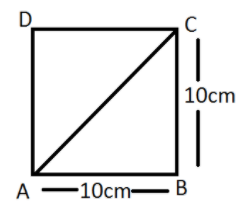
Find the diagonal of a square whose side is \[10cm\].
Answer
494.4k+ views
Hint:As we know the side of the given square is \[10cm\]. And in a square, all the four sides are equal to each other as well as all the sides interest to its adjacent side at \[{90^0}\]. Therefore, the figure formed by joining the two opposite vertices of a square, is a right-angled triangle with two equal sides.
Complete step-by- step solution:

Given that Side of the square is \[10cm\]
In right angled\[\vartriangle ABC\]
Using Pythagoras theorem
\[A{B^2} + B{C^2} = A{C^2}\] \[\left[ {Bas{e^2} + Perpendicular{r^2} = Hypotenuse{e^2}} \right]\]
As we know, the sides of a square are equal to each other.
$\Rightarrow$ \[AB = BC\]
$\Rightarrow$\[{10^2} + {10^2} = A{C^2}\]
$\Rightarrow$\[100 + 100 = A{C^2}\]
$\Rightarrow$\[200 = A{C^2}\]
$\Rightarrow$\[AC = \sqrt {200} \]
$\Rightarrow$\[AC = \sqrt {2 \times 2 \times 2 \times 5 \times 5} \]
$\Rightarrow$\[AC = 2 \times 5\sqrt 2 \]
$\Rightarrow$\[AC = 10\sqrt 2 \]
Therefore, the diagonal of square will be \[10\sqrt 2 \]
Note: A square can have two diagonals. Each of the diagonal can be formed by joining the diagonally opposite vertices of a square. The properties of diagonals are as follows-
Both the diagonals are congruent (same length). Both the diagonals bisect each other, i.e. the point of joining of the two diagonals is the midpoint of both the diagonals. A diagonal divides a square into two isosceles right-angled triangles. The sum of all the internal angles of a square is equal to \[360 \circ \]and a square is a regular quadrilateral that has four equal sides and four same angles.
The diagonal of a square with side ‘a’ can be calculated using a formula \[a\sqrt 2 \]. Remember, both the diagonals of a square are equal to each other.
Complete step-by- step solution:

Given that Side of the square is \[10cm\]
In right angled\[\vartriangle ABC\]
Using Pythagoras theorem
\[A{B^2} + B{C^2} = A{C^2}\] \[\left[ {Bas{e^2} + Perpendicular{r^2} = Hypotenuse{e^2}} \right]\]
As we know, the sides of a square are equal to each other.
$\Rightarrow$ \[AB = BC\]
$\Rightarrow$\[{10^2} + {10^2} = A{C^2}\]
$\Rightarrow$\[100 + 100 = A{C^2}\]
$\Rightarrow$\[200 = A{C^2}\]
$\Rightarrow$\[AC = \sqrt {200} \]
$\Rightarrow$\[AC = \sqrt {2 \times 2 \times 2 \times 5 \times 5} \]
$\Rightarrow$\[AC = 2 \times 5\sqrt 2 \]
$\Rightarrow$\[AC = 10\sqrt 2 \]
Therefore, the diagonal of square will be \[10\sqrt 2 \]
Note: A square can have two diagonals. Each of the diagonal can be formed by joining the diagonally opposite vertices of a square. The properties of diagonals are as follows-
Both the diagonals are congruent (same length). Both the diagonals bisect each other, i.e. the point of joining of the two diagonals is the midpoint of both the diagonals. A diagonal divides a square into two isosceles right-angled triangles. The sum of all the internal angles of a square is equal to \[360 \circ \]and a square is a regular quadrilateral that has four equal sides and four same angles.
The diagonal of a square with side ‘a’ can be calculated using a formula \[a\sqrt 2 \]. Remember, both the diagonals of a square are equal to each other.
Recently Updated Pages
The correct geometry and hybridization for XeF4 are class 11 chemistry CBSE

Water softening by Clarks process uses ACalcium bicarbonate class 11 chemistry CBSE

With reference to graphite and diamond which of the class 11 chemistry CBSE

A certain household has consumed 250 units of energy class 11 physics CBSE

The lightest metal known is A beryllium B lithium C class 11 chemistry CBSE

What is the formula mass of the iodine molecule class 11 chemistry CBSE

Trending doubts
Explain the system of Dual Government class 8 social science CBSE

What is Kayal in Geography class 8 social science CBSE

Who is the author of Kadambari AKalidas B Panini C class 8 social science CBSE

In Indian rupees 1 trillion is equal to how many c class 8 maths CBSE

Write the smallest number divisible by both 306 and class 8 maths CBSE

What led to the incident of Bloody Sunday in Russia class 8 social science CBSE





